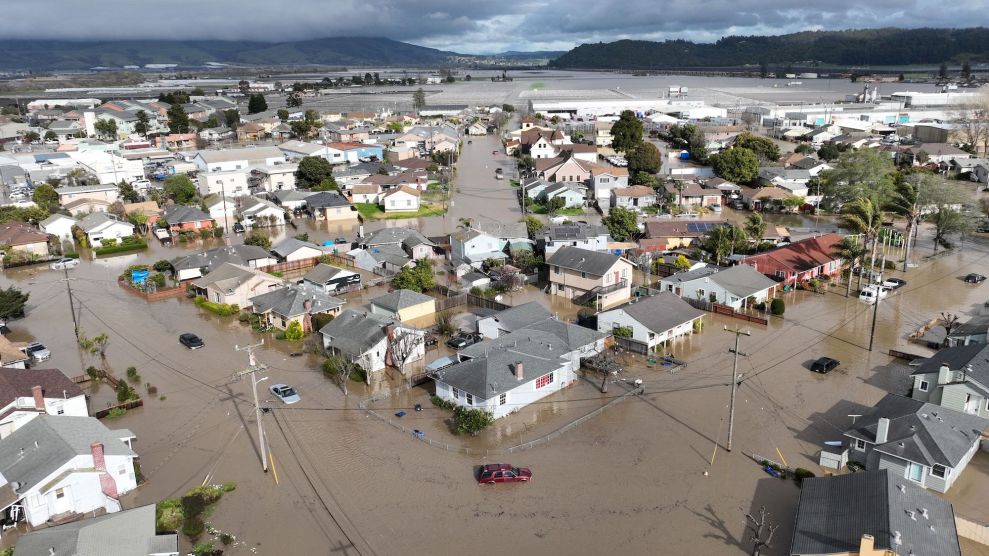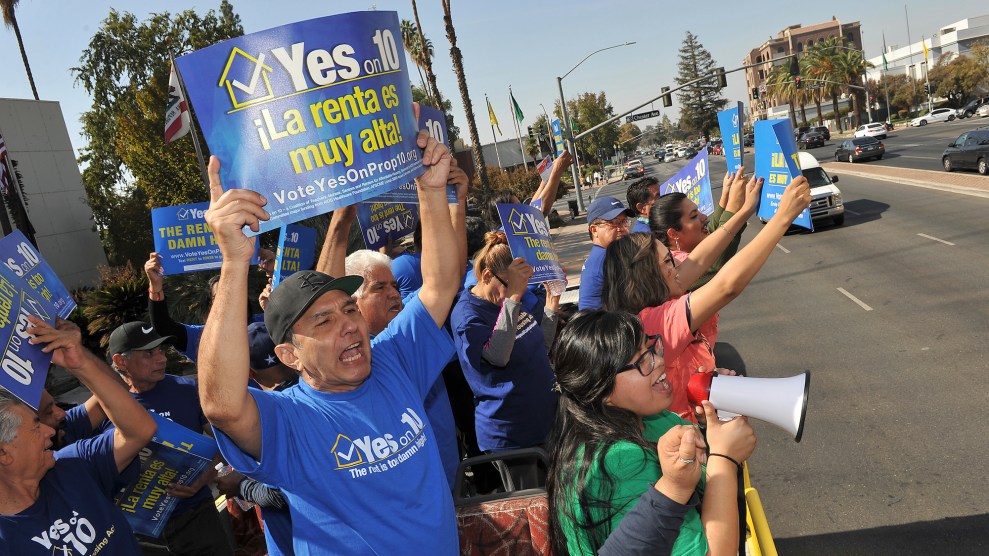
Residents were forced to evacuate in the middle of the night last March in Pajaro, California.Josh Edelson/AFP/Getty
This story was originally published by the Guardian and is reproduced here as part of the Climate Desk collaboration.
Minerva Contreras can’t keep up with the bills.
Recently, after a series of extreme heatwaves in California forced her family to run the AC, her monthly electricity costs rose to about $500. Her water bill averages around $100, but because the water is contaminated with pesticides from nearby agricultural fields, her family spends an additional $140 each month to purchase jugs of drinking water. Her grocery bills have gone up as well, after a spate of winter storms disrupted harvests across the state.
“Practically, about one week’s paycheck goes toward rent, the next week’s toward the electrical bill, and the third week’s toward the gas and water bills and the remaining for everything else,” said Contreras, a farm worker who lives with her husband and two sons in small, agricultural town of Lamont. “We just can’t keep up.”
Here, in what is already one of the most expensive states in the US, the climate emergency is driving up the cost of living. Extreme weather, drought and drastic swings in temperature, all fueled by global heating, are affecting utility costs and insurance premiums, exacerbating housing shortages and causing food prices to go up.
These issues are echoed throughout the US and the globe, as relentless heat and smoke pollution from wildfires push communities across the southern US, Europe and Asia to their limits. The health and economic impacts of the spate of extreme weather will become clearer in the months to come.
But in California, the cost imposed by the disquieting recurrence of climate-related disasters that more and more countries are faced with have already become untenable for many. Nearly half of the state’s residents say they struggle to save money or pay for unexpected expenses, according to a recent poll by a consortium of local nonprofits.
Many families are just one fire or flood away from financial ruin. “We don’t see a future here, and it’s a shame we can’t escape either,” Contreras said. “Where would we go?”
As temperatures in Lamont this week topped 113F, Contreras worried about how much her family might have to run the AC. “We are usually very careful and try not to,” she said. “We put up with a lot of heat before we turn it on.”
Each summer for the past few years, Contreras’s family has fallen behind on their electricity bills. Each year, they sign up for repayment plans and manage to pay down their arrears by February or March, only to fall behind again as the warmer season begins.
Her family is not alone. California residents are increasingly facing higher electricity prices, at a time when extreme weather is making energy demands go up. Utility rates in the state are already the highest in the US, with California’s Public Utilities Commission finding that since 2013, rate increases have outpaced inflation.
One major reason is that electricity companies have faced increasing wildfire mitigation expenses like clearing vegetation around power lines and higher wildfire insurance costs and they have passed the charge on to consumers. Meanwhile, utility companies such as PG&E have also been allowed to pass on the liability costs of sparking some of the state’s most destructive wildfires.
For many households, the price increases mean dire choices, said Michael Méndez, assistant professor of environmental planning and policy at the University of California, Irvine. A survey by researchers at Columbia University found that nearly 30 percent of households in California kept their homes at a temperature that was unhealthy or unsafe to save on energy costs. “When you overlay existing social, economic and health disparities with climate change and extreme weather, that exacerbates inequalities,” Méndez said.
“People are not only facing a rise in costs, but also increased variability in costs,” said Alan Barreca, a professor at the Institute of the Environment & Sustainability at UCLA.
Barreca and his colleagues have found that for each August day when the temperature was 95F or higher, the chance that a low-income family would fall behind on bills and have their power disconnected increased by 1.2 percent.
A new proposal to adjust electricity fees based on their income could help, Barreca said. Researchers and advocacy groups have also proposed offering adjusted rates and discounted electricity during extreme weather events and establishing a rental right to cooling.
Climate change is taxing the water supply as well as the electrical grid. One in eight households across California are behind on their water bills, owing about $1 billion altogether, as cycles of lengthy drought dwindle water supplies. A survey by the state’s water board found that households in predominantly Black and Latino neighborhoods were more likely to be in arrears.
“With water, the existing system was already not working,” said Rachel Cleetus, a climate and energy program director at the Union of Concerned Scientists, a science advocacy organization. “And now it’s really falling apart in the face of the pressures from climate change.”
Due to a complex and outdated water rights system that in many areas favors big agriculture over communities and aging, ailing infrastructure, many of the state’s poor and rural communities have struggled to access adequate drinking water, she said. Then, in recent years, long stretches of drought have caused shortages and spiked prices. Wildfires and a series of catastrophic floods this winter have caused further complications, tainting water supplies and damaging critical infrastructure.
Contreras and her family, who have lived in Lamont for about 12 years, have been informed year after year that the stuff coming out of their taps isn’t safe for consumption due to a legacy of pesticide pollution seeped in the groundwater system.
In other parts of the Central Valley, chronic overpumping has depleted water, and left homeowners with dry wells. Hundreds of families in the San Joaquin valley continue to receive water deliveries by truck, despite a winter of record-setting precipitation.
“California already has a huge challenge with inequity,” said Cleetus. “It has a high poverty rate. There’s already an affordable housing crisis in the state. And these kinds of climate risks are just adding an additional layer of risk, and deepening the inequities.”
In the small, rural town of Midpines, at the south-western edge of Yosemite National Park, Beth Pratt says she has seen the climate crisis reshape her community. Last year, the explosive Oak Fire burned nearly 100 homes here.
“In my work as a conservationist, I advocate for wildlife who are threatened because of climate change. Now we’re starting to feel that same vulnerability,” said Pratt, who is the regional executive director of the National Wildlife Federation. “This is the first time I felt really vulnerable about losing my home.”
Last month, the state’s largest property insurance companies—Allstate and State Farm—announced that they will no longer sell new policies in California, citing the growing risk of catastrophes. The news came as renters and homeowners across the state were quietly dropped by insurance companies, or were facing unaffordable premiums.
This month, not long after Allstate announced it would halt new policies in the state, Pratt got notice that the company would not be renewing her existing policy.
That was despite the fact that Pratt had spent about $100,000 to harden her home against fire. She invested in fire-rated metal siding for the house, redid her redwood decks in ember-resistant laminate and metal railings. She purchased a 2,500-gallon tank with a fire hose hookup, and this year, she spent $10,000 to hire a crew to clear trees and overgrowth.
When the letter from Allstate came, telling her that even all that was not enough to keep her home insured, Pratt was flabbergasted. “I mean, $100,000 is not something the average person has,” she said. “I don’t really have it—on a nonprofit salary. I had to refinance my mortgage to afford this.”
Most of her neighbors are facing the same issue, she said—they’ve either lost their insurance already, or expect to lose it soon. After the record-breaking 2020 fire season, the number of Californians who were told by their insurer that their policy wouldn’t be renewed increased by about 30 percent.
The only remaining option for Pratt and her neighbors is the state’s Fair plan, a limited insurance plan for those who cannot find coverage through a private company. It will cost Pratt double what she was paying Allstate.
Moving and buying elsewhere isn’t financially feasible—and besides, Pratt said, she’s lived in this small community for 25 years. “We can’t just move away from the climate crisis.”
In fact, many poor and middle-class families are being forced to move to areas that are feeling the impact of climate crisis more intensely. “The housing affordability crisis in California is pushing people out of cities and increasingly out, into locales with a higher risk for extreme heat, higher risk for drought and wildfires,” said Méndez.
In the towns of Planada and Pajaro, farm workers without flood insurance or access to unemployment aid saw their homes and life savings wiped out by floods this winter. Aid from the Federal Emergency Management Agency wasn’t enough to cover the cost of materials, let alone labour, to rebuild.
Agricultural workers in the central coast and Central valley, who harvest the bulk of produce grown in the state and in the country, were out of work for weeks. Planted fields of summer fruit were wiped out and shortages drove up already inflated grocery prices this year.
In Lamont, where daily highs are predicted to remain above 100F through the end of the month, the Contreras family has resigned to another year of debt. Because it is unsafe to work in the fields after 11am on most days, Contreras’s husband has had his work hours cut. Normally he would pick up extra work in the tangerine or grape fields, but the weather has disrupted those harvests as well.
Recently, the family had to sign up for a second repayment plan for their electrical bills. “It’s depressing,” Contreras said. “The bills just keep accumulating.”
The family thinks about moving, but can’t think of where they could live affordably. “Everywhere in California, we see that it’s the same,” she said.















